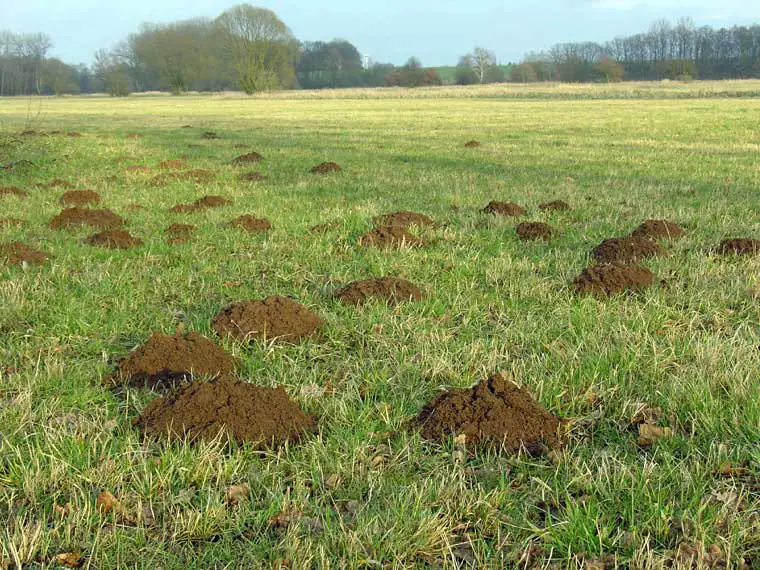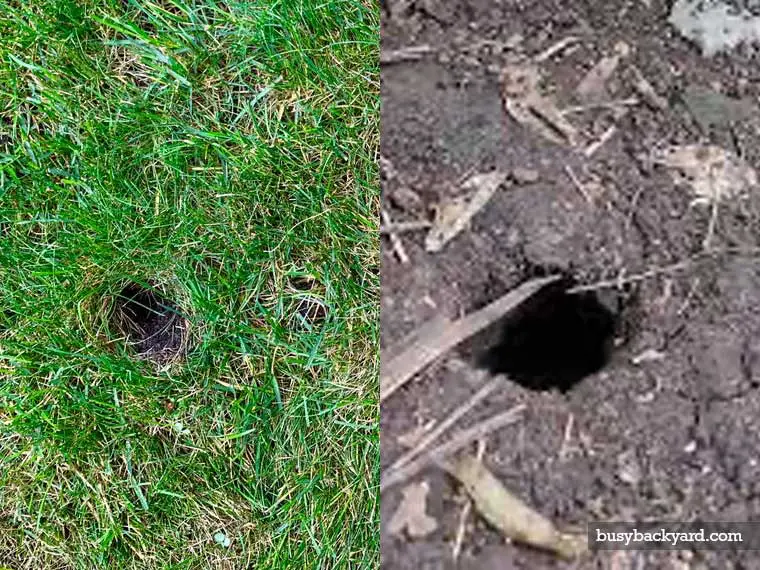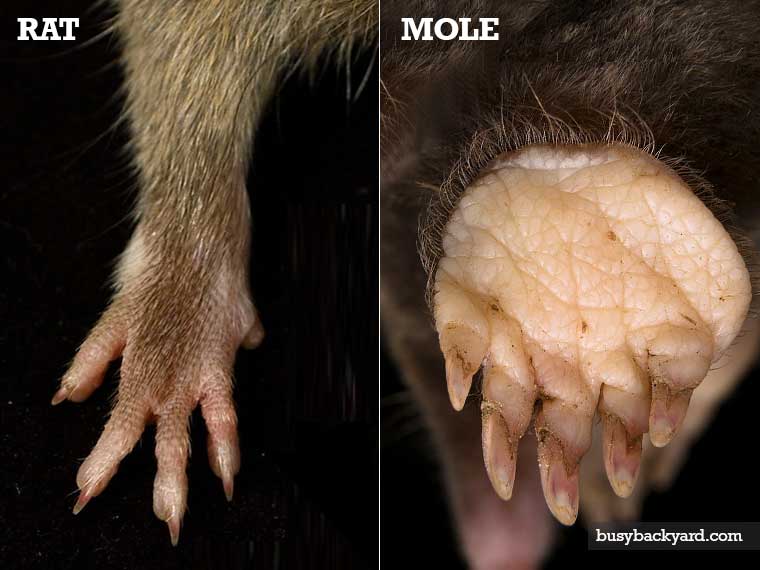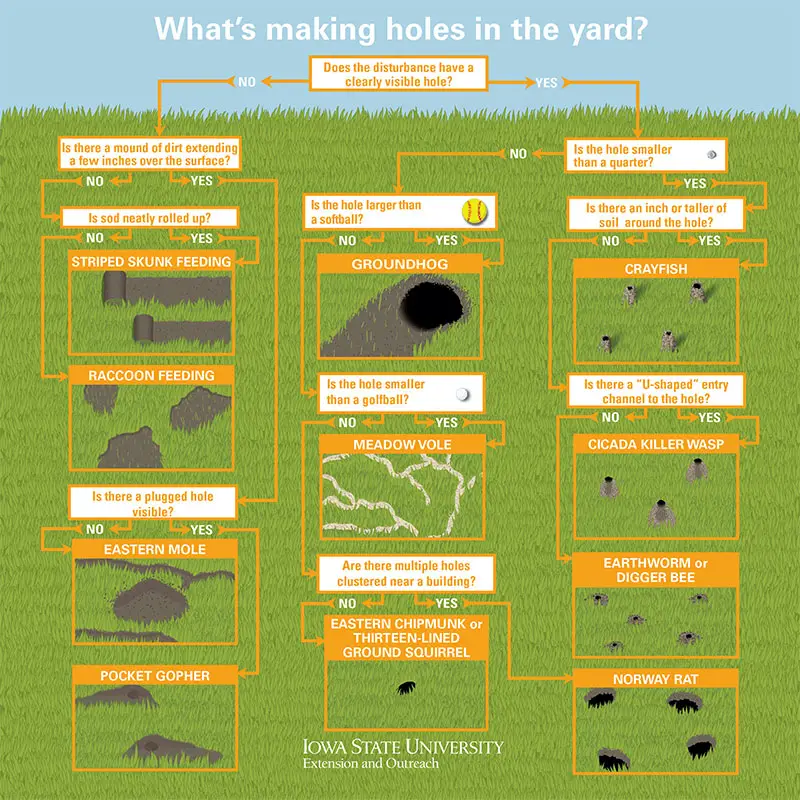Over the last 5 years I’ve spent a lot of time creating the perfect backyard environment and lawn. Sadly, the local critters didn’t appreciate it as much as I did: we had mole and rat problem (both at the same time).
I’ve managed to get rid of them both now, but it did take some time. As a result, I am very well placed to explain the whole mole holes vs rat holes debate. This includes the differences between rat and mole holes, and how they burrow or tunnel.
The difference between rat and mole holes
The easiest way to identify whether it’s a mole hole or rat hole is by location and appearance. In simple terms, mole holes will have a circular mound of earth over the top, plugging and covering the hole. Some people have compared the mound to volcano or shallow cone shape.
In truth, you won’t see a physical mole hole because it’s covered. Here’s what mole holes look like. They are very different to rat holes.

Rats on the other hand will leave very visible holes and don’t leave large mounds, similar to vole holes. A rat hole will usually be open and obvious. It can be a couple of inches in diameter.
Another difference in the mole vs rat hole question is where the holes and tunnels have been dug.
Moles will burrow holes and tunnels than can be up to a meter under your backyard lawn, and (almost unbelievably) can be as long as 70 meters. They don’t stop there either. Moles holes can continually grow year on year.
Moles really are the greedy property developers of the animal world. They are happy to dig tunnels in the middle of lawns and in open spaces.
Rats are different.
They tend to dig holes along fence lines, near walls, underneath bushes. It’s very unusual for a rat to dig a hole in the middle of a garden or backyard lawn. This is because they feel exposed out in the open and prefer the cover a fence line or foliage gives them.
This is what a rat hole looks like.

Other ways to solve the rat holes vs mole holes debate is the volume.
If you see lots of mounds of earth within a 10-meter area, it possible they have been dug by just one mole. They are territorial and tend to be alone in your backyard.
It’s also worth mentioning that mole activity is usually at its peak in late winter and early spring times.
Here’s a quick comparison of a rat vs mole hole.
What rat holes look like in your yard
- No large mounds of dirt at the entrance to the hole.
- Rat holes have several entrances.
- Tunnel entrances are 2 to 4 inches in diameter.
- Do not plug or cover the entrances to their holes.
- Like to burrow along fence line and in dense vegetation such as under bushes, near a food and water source, and preferably in sandy soil.
What mole holes look like in your yard
- No visible mole hole.
- Mound of earth piled up in a volcano or rounded cone shape.
- Might see a network of tunnels evident near the surface of your lawn.
Other ways you can tell whether it’s a rat or mole burrow is evidence left in your backyard. Rats like to eat fruit, vegetables, seeds, bulbs, and plants. Moles eat insects and larvae, and not plants.
How to get rid of moles in your yard
If there are no rats, and it is indeed moles in the holes, here are 5 humane ways you can get rid of them from your backyard.
- Electronic deterrents: this device on Amazon (click pic below) emits sonic pulses that you can’t hear, but moles can, and they are said to hate it and will leave your yard.
- Humane mole repellents: you can also buy granules on Amazon that you put in your yard, a mole will taste it, hate it, and hopefully move on sharpish!
- Mole netting: this is more preventative, as you place the netting underneath a lawn before it’s laid. It’s not a favorite of mine, as it’s adding plastic to the ecosystem of your yard.
Do rats tunnel like moles?
Rats do make tunnels, but not like moles do. This makes sense when you look at the anatomical make-up of a mole compared to a rat. In the image below, notice how their front paws differ.

Notice how the mole’s paw is shaped like a shovel. Compare that to a rat’s paw which doesn’t have a large palm, and instead long claws.
Rats can dig tunnels, but unlike moles, they are not suited to it. Moles are built for digging burrows, versus rats who are more suited to lots of different tasks.
Whilst moles will dig tunnels underneath open areas, such as in the middle of backyard lawns, rats prefer to burrow near cover. That means they will mostly dig along fence lines, walls, or under a bush.
Another difference between rat and mole holes is how deep and far they both dig.
Rat tunnels will rarely be deeper than half a metre (19 inches), whereas moles tunnels and burrows can be up to 70 cm (27.5 inches) deep and a whopping 70 metres in length!
To conclude rats do not burrow like moles. Moles will dig deeper, longer, and at incredible speeds, something like 12 inches a minute. If you look at those paws again, you can see why they are able to dig better than rats can.
Do rats dig holes like moles?
As now established, rats don’t dig holes like moles. Rat holes tend not to be plugged, won’t be covered in soil, and are unlikely to be seen in the middle of lawns.
Rats almost always dig alongside a man-made wall or fence, or near corners. They do this so they have cover and camouflage against predators.
Some believe it’s related to thigmotaxis, where rats like to stick close to walls or close to the edge of fields, as described on ScienceDirect.
“Behavioral variables that are commonly measured in this test include thigmotaxis (the tendency to remain close to the walls) and defecation. Thigmotaxis is quantified by determining the proportion of time the animal spends close to the walls versus in the center of the arena.”
Do rats live in mole tunnels?
It’s unlikely to find rats living in mole tunnels, as the two animals will avoid each other. Rats won’t want to use a tunnel that a mole is also using, as they become anxious when things change.
For example, if a mole was to dig another chamber in a tunnel a rat was using, the rat won’t like it, and will likely leave.
However, rats might use a mole tunnel to travel, or takeover a mole tunnel that a mole no longer lives in.
Handy Hint: Rats can squeeze through very small holes so you should seal up anything that leads into your home.
Rats vs moles: what would I rather have?
Whether I would rather have a mole or rat burrow is easy for me to answer. Whilst moles will damage my lawn (even artificial ones), both can tunnel under patios, and possibly lead to small tunnels collapsing in your backyard.
But rats carry a lot of disease and are far harder to get rid of. They are very resilient and will keep coming back again and again.
The disease rats carry include:
- Hantavirus
- Lymphocytic Choriomeningitis virus (LCMV)
- Plague
- Rat bite fever
- Tularemia
Perhaps it’s a different critter altogether?
Unless you have seen a rat or mole in your yard, you can never be 100% certain what is digging the holes. Here’s a handy visual guide from the Iowa State University which might help you identify the culprit.

It’s never a welcome sight to see critter holes and mounds appearing in your backyard. Whether it’s a mole, rat, squirrel, or even a snake, all can and do cause damage to gardens and lawns.
But the scale of their damage depends on certain factors, which is why it’s helpful to understand the difference between a mole hole and a rat hole.



